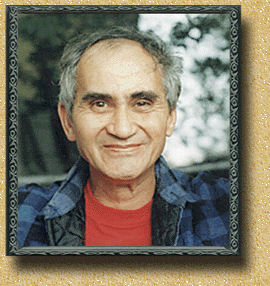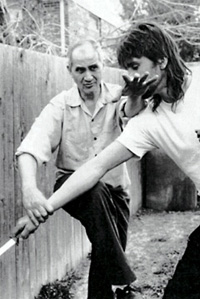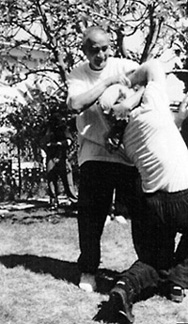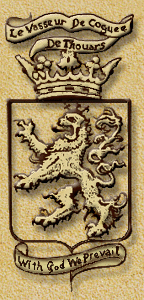
Willem
de Thouars was born into a true lost world. The jungles and plantations
of Java in the 1930s were shortly to undergo a cataclysm of change their
society was hardly prepared for. For nearly 450 years the islands of the
Dutch East Indies patiently endured an exploitive colonialism without
significant disruption to their ancient cultures. But in the span of barely
two decades, first with the occupation of a brutal Japanese army and then
a protracted nationalist war against the Dutch, Java and her companion
archipelago suffered the deaths of millions, and permanent damage to their
institutions.
Since the war, Java has tripled its population and the fledgling nation
of Indonesia has embraced industrialism in a race to the economic ascendency
of the Pacific Rim. So, although the martial arts are still widely practiced,
most of the teachers of Pencak Silat and Kun Tao, schooled by the tradition
of centuries, have died or emigrated. So the land of tigers, temples and
mystical old men teaching young boys has changed forever. Willem and his
handful of contemporaries represent a vanishing legacy of another time.
Willem practices some fifteen styles of Pencak Silat, the native arts
of Indonesia, and eight styles of Chinese Kun Tao. These represent the
core elements of the practice of the Kun Lun Pai, Willem's martial brotherhood,
dedicated to preserving these arts in a dozen countries on four continents.
Practitioners in the Pai stress practical fighting principles but also
study the myriad possibilities of technique that flow from a single principle.
Like a cut diamond, the light of one technical concept can be reflected
in dozens of variations according to style or situation.
It is a normal condition of Willem's instruction to see him change the
same technique twice in two repetitions. The changes are frequently elusive
and subtle, and learning to recognize the slight change of the angle of
a foot or the order in which he passes a hand in an entrance is key to
opening the door of understanding his systems.
 Willem
is fond
Willem
is fond
of the word
"struggle." In
class, he will
demonstrate a
technique or
form, hand it
over to the
students and
say, "O.K.,
now struggle
with it"
Willem's
styles, though complex to the western eye, are based on simple principles.
His study has occurred in the "old way" and he passes that tradition
on to his students who teach in a "new" world. And we in the
West are unused to teachers who teach "global" concepts rather
than rote "linear" steps. Willem's wide range of possibilities
reflect a lifetime of learning that spanned the world.
After his early life moving around Indonesia, Willem became a Dutch merchant
marine. He writes, "I learned the facts of life as a young seaman.
I was exposed to a variety of fighting styles. I visited and researched
various martial arts societies in Malaysia, Formosa, Hong Kong, Japan,
Sri Lanka, India, Pakistan, Italy, Greece, Portugal, Spain, France, Holland,
England, the United States, Canada, and several South American countries.
Those experiences are treasured by me today. I was exploring the real
world."
This extensive period of travel, and Willem's insatiable curiosity, define
the learning ethic of the Kun Lun Pai. Pai practitioners are encouraged
to examine every aspect of the martial arts, and indeed life in general,
to find what works for them. This takes the Bruce Lee philosophy of "absorb
what is useful" to the next evolutionary step. The last half of that
statement was to "discard the rest." In Willem's approach, nothing
is thrown away. Since every individual is different and each situation
or opponent is different, no hard and fast absolute laws will apply. What's
more, a practitioner's path in the martial arts does not resist the passage
of time. A technique that seemed to not work ten years ago, might suddenly
find itself useful after it ages in the mind.
Willem uses several metaphors to describe his arts. He talks about his
"backyard." This is Willem's game, his home turf and his training
ground. When the inevitable comparisons come, he tends to shed labels
like "internal" or "external" and calls it his backyard.
This is an appropriate metaphor, because Willem's backyard in Northglenn,
Colorado tends to be worn out from the combination of training sessions
and the four dogs he loves so dearly, and Willem never throws anything
away, so the sides are lined with old furniture that needs hauling to
the dump, and assortments of rusting garden tools. "Yah!" Willem
says, "They're rusting but they still work, just like me!"
Willem refers to technical fighting principles as "tools," and
that everyone can only have so many in their own tool box. This puts the
arts in the light of being a means to an end. But there is no end in sight,
and he is fond of discussing why one practices martial arts. lndeed with
the rather vast selection of tools at his disposal, Willem can only carry
so many to one seminar or class. But within the space of a few hours it
is truly astonishing to realize just how many that can be. And to carry
the metaphor a bit further, realize that Willem has been a machinist most
of his adult life. His tools are built to create other tools. And that
is the nature of his teaching. His classes are a period of shared exploration
rather than a lesson. Willem shows one of his entrances, and the student
struggles to reproduce it, in the process he is teaching himself.
Willem is fond of the word "struggle." In class, he will demonstrate
a technique or form, hand it over to the students and say, "O.K.,
now struggle with it." This is classical old-style teaching. He doesn't
give too much mechanical information, because the best teacher is the
self. And Willem believes that life is a struggle. Coming through years
of forced internment, first by Japanese invaders, then by Indonesian nationalists,
then struggling to find a place in the world, Willem's point of view is
understandable.
It is not politically correct anymore to view life this way. In the west,
where one merely has to flip a switch to get pure water or dependable
electricity, people are uncomfortable with the idea of struggle. But through
struggle, Willem maintains, man improves himself, and in an increasingly
technologically "soft" world, man must seek out struggle to
understand himself. But Willem always giggles when he talks about struggle
and the "sting of pain." That is because he knows it can be
a happy struggle and one where victory is achieved. Without struggle
and pain there can be no victor. What is vanquished are the limitations
of the past, and the victory is the new self.
It is important to note that a discussion of the differences between Pencak
Silat and Kun Tao is difficult because of the limitations of the English
language. It requires a keen eye and years of exposure to recognize these
differences, and a student realizes he has both arts inextricably entwined
with one another. But writers have attempted to separate these arts with
words as though they were Siamese twins and with about the same degree
of success. Herein lies the problem: If a student called one of Willem's
senior practitioners on the phone for a definition of these arts without
a physical demonstration, they would use words like "bone breaking,
punishing art that attacks immediately and hits you all the way down,"
to describe, say, Pencak Silat. Then, you call another senior and he might
describe Kun Tao using the same words or other non-definitive English
that leaves one perplexed. To understand what separates these arts can
only be demonstrated in person. Even video cannot make it clear to the
uninitiated.
Willem uses the question, "What do you feel" to explain himself.
And frequently the answer is, "I don't know what I feel. I feel the
floor and I feel a whole bunch of things hitting me, but I have no idea
how I got here." And once again the student has to do some serious
exploration for answers. The difference in the flavor between the Pencak
Silat styles and Kun Tao is best understood by feel.
Indonesian martial arts have
|
|
become extremely popular in the fad-crazed world of the 1990s. Twenty years ago they were virtually unheard of and school owners and tournament fighters didn't very much appreciate the presence of people like Willem de Thouars and his brothers. These funny looking people wouldn't stay put when you tried to hit them and they didn't seem to care about the accepted rules of martial arts.
The stories
are legion of Willem and his brothers getting kicked out of other people's
dojos and shunned by
the establishment of the "karate community." The de Thouars
were opinionated and embarrassed trophy winning champions with their "tricks."
On one occasion Willem interrupted a brick breaking demonstration by walking
across the gym floor and significantly denting a solid steel door, stating,
"That is power!" He sat back down before a stunned crowd. And
he was never invited back to that tournament.
One promoter took a liking to Willem, though, and during a demonstration
the crowds were again shocked. Willem instructed one of his practitioners
to hit him with an oak staff. Before Willem was quite ready the practitioner
hit him right across the ribs. Willem shook it off and asked to be hit
again. This time Willem flipped the 250-pound student with his own staff,
and then broke the 7/8-inch-thick oak with a single snapping blow. During
these years, the classes of Willem and the brothers remained indistinctly
tiny. And they gained no respect from the martial arts community.
Nowadays, there are more "experts" in Pencak Silat than you
can shake a stick at, and Willem can't keep up with the ever-growing requests
for seminars. In this light, a straightforward explanation of terms
is necessary.
Pencak, pronounced PENT-JACK, means a dance-like movement. In the language
of Bahasa Indonesia, the context of this definition is the dance like
simulation of the movements of fighting.
Silat, pronounced SEE-LOT, is a term that generically describes any form
of unarmed combat. Silat indicates the actual practice of fighting.
So in Indonesia the terms are both inseparable and interchangeable. The
combination indicates a balanced practice. Both the practice of the movements
of the form in a rhythmic aesthetic presentation, as well as the practice
of actual sparring or combative contests. The practitioner to be truly
skilled must assert both aspects of this art, and thus the art yields
both beauty and practicality.
Kun, pronounced KOON, means "fist" in archaic Chinese. It is
the derivative of the modern Chuan or Chuen, which has come to mean practice.
Kun is one of those Chinese terms that have interchangeable uses, one
that is applicable here, is "the unmoveable" or the "base
of the mountain."
Tao, Willem pronounces this with a "t" sound as in TAU, to differentiate
it from DOW. It literally means way or path, but is perhaps the most ill-defined
word in the Chinese language because of its multiple uses in Taoist religion
and philosophy.
Together, Kun Tao means "fist way." It is the oldest term used
to describe the martial arts of China that can be found. And as such it
has disappeared from use in all but those Chinese satellite countries.
such as Indonesia, Malaysia and the Philippines, where Chinese culture
has remained relatively untouched by time.
There has been discussion in the martial arts print media as to whether
Kun Tao is an Indonesian, Malaysian, Philippino or Chinese art, The answer
is "yes." Kun Tao goes back to ancient China, so it is accurately
a Chinese art, but both Chinese and indigenous people in Southeast Asia
have practiced and adopted it as their own. And the old men who were trained
in what they see as the "pure art" have seen it sanitized and
changed, and it literally doesn't exist in its original state in China
anymore.
So Willem's training as a young man came from both of these sources, which
in the Indonesia of his day was highly unusual. Culturally the Chinese
of Indonesia tended to be very clannish, and their ethnic styles of selfdefense
were confined to other Chinese. And because of the Indonesian prejudice
against all things Chinese, Willem's cross-training has made him a controversial
figure with some martial artists. But Willem is unconcerned with the endless
politics of the martial arts. His focus is to use what works. He honors
his teachers and is not ashamed of where they come from. He espouses a
policy that looks for useful information from whatever source.
Indeed his lineage includes both a Chinese Taoist monk and at least one
Moslem Imam, and also an English boxer and a Belgian fencing teacher.
He developed training methods from Charles Atlas and has Joe Louis as
his boxing hero.
Willem is a breath of fresh air in a martial arts world stale with ancestor
worship and hard non-yielding approaches. His voice is a chorus
of a rainbow experience that inspires one to "sing his own song."
 Willem
uses
Willem
uses